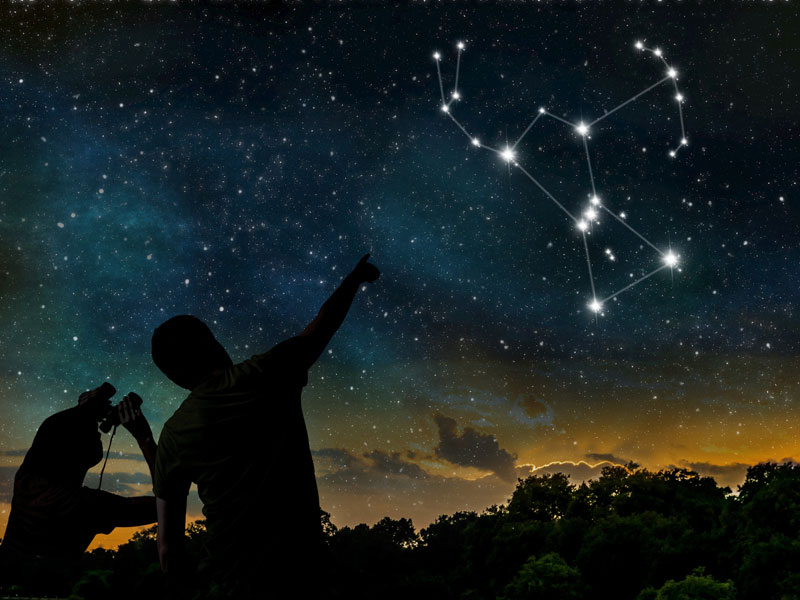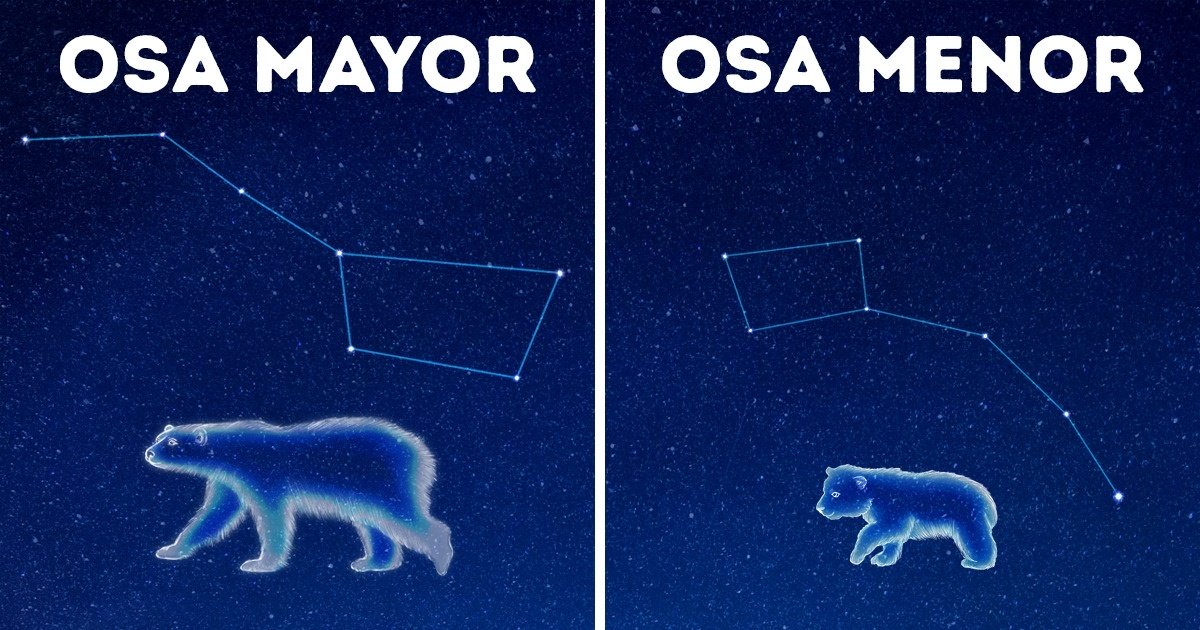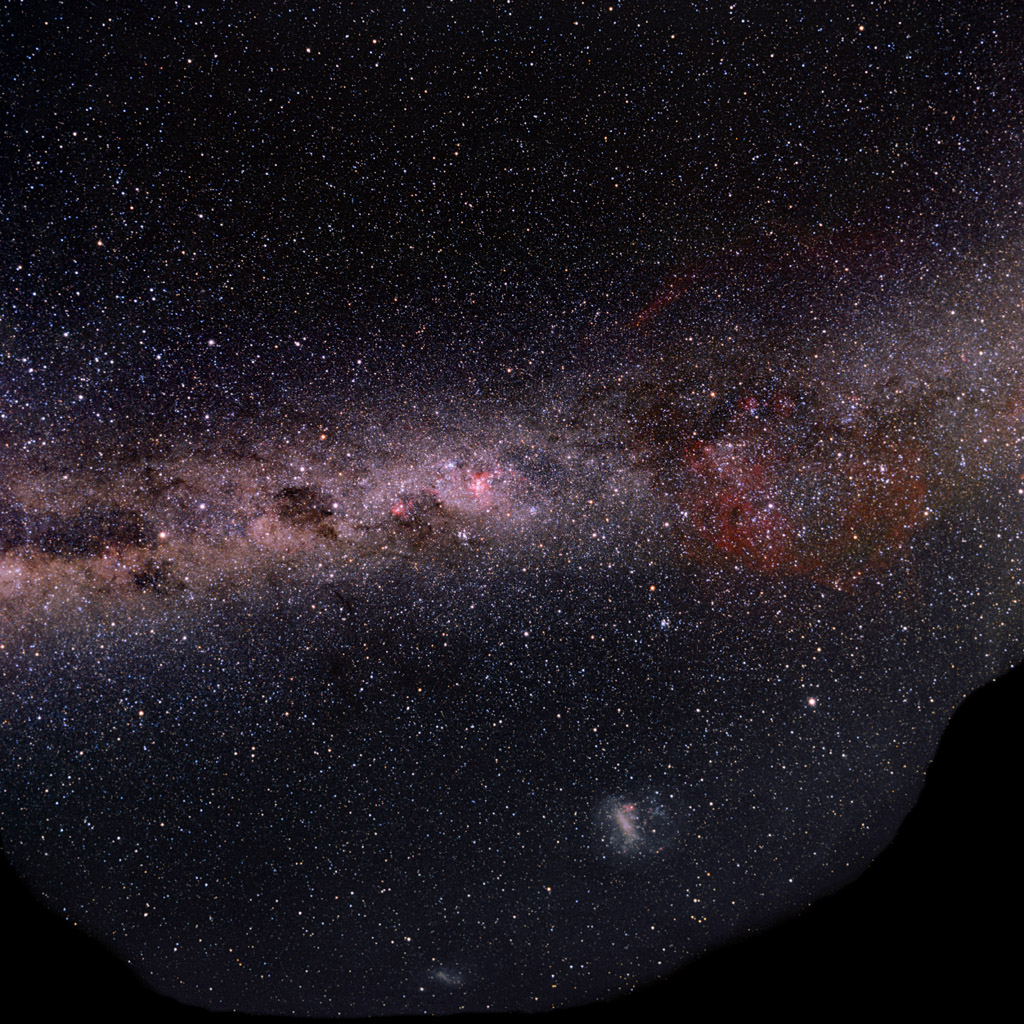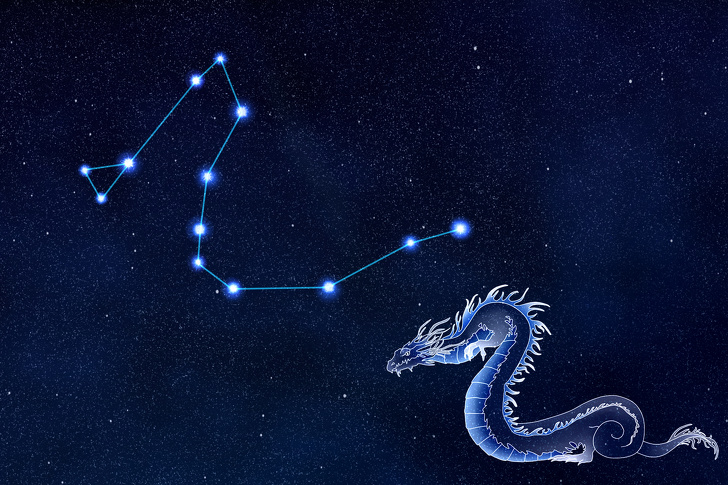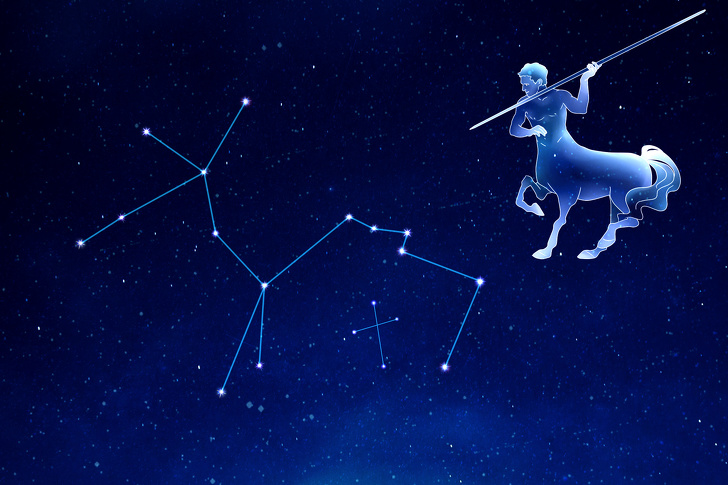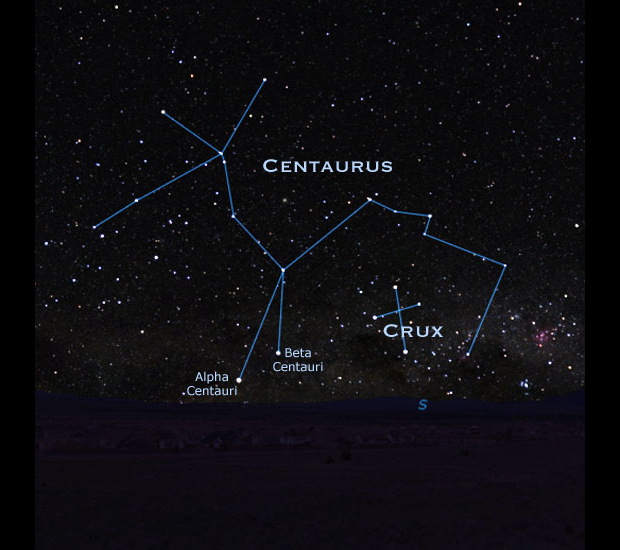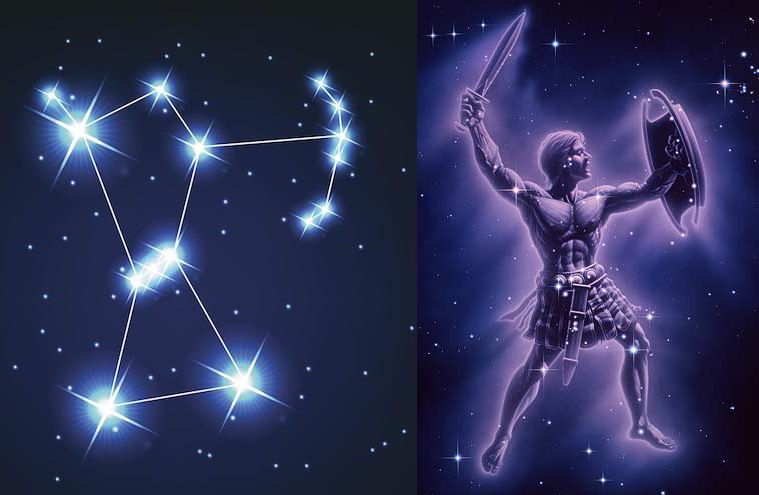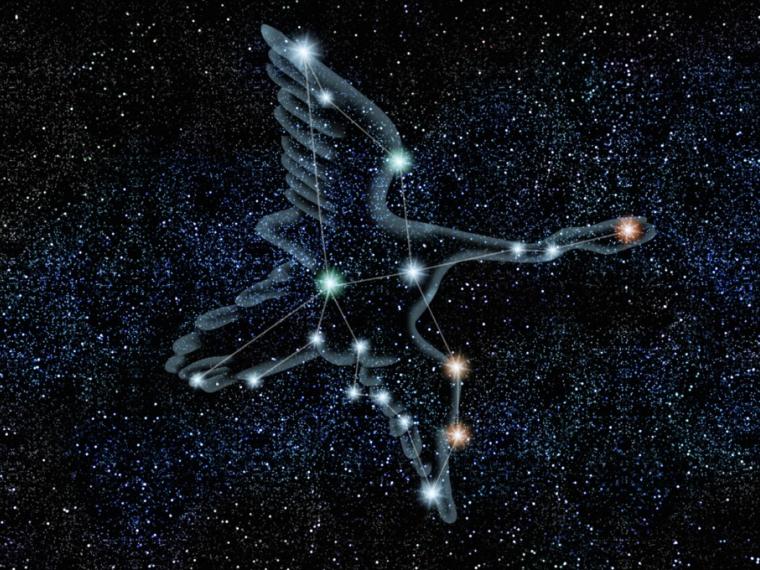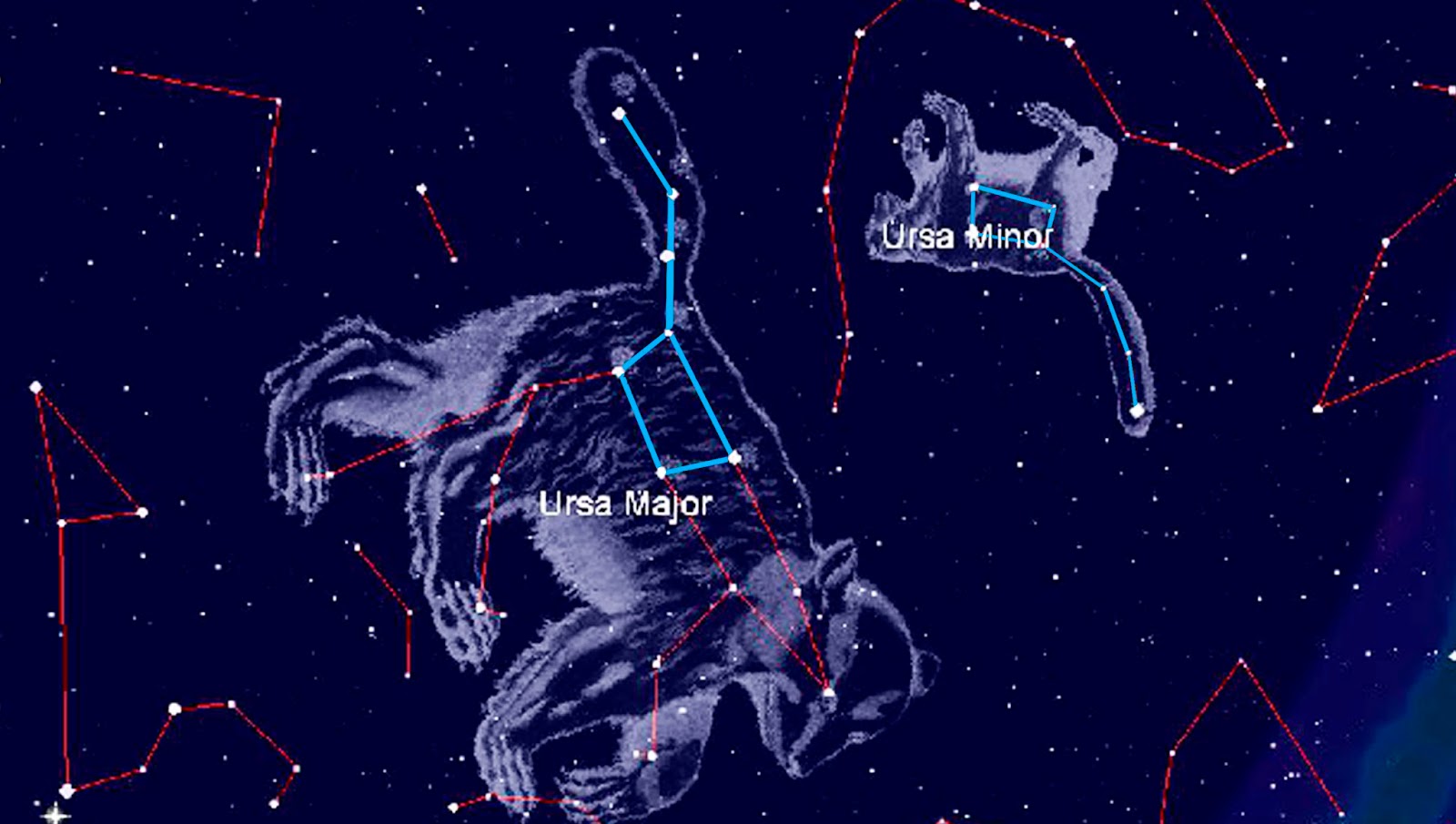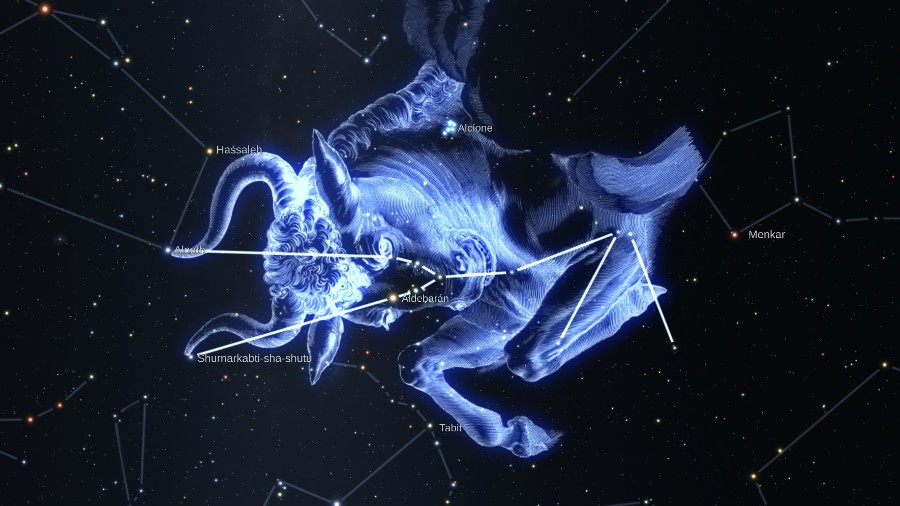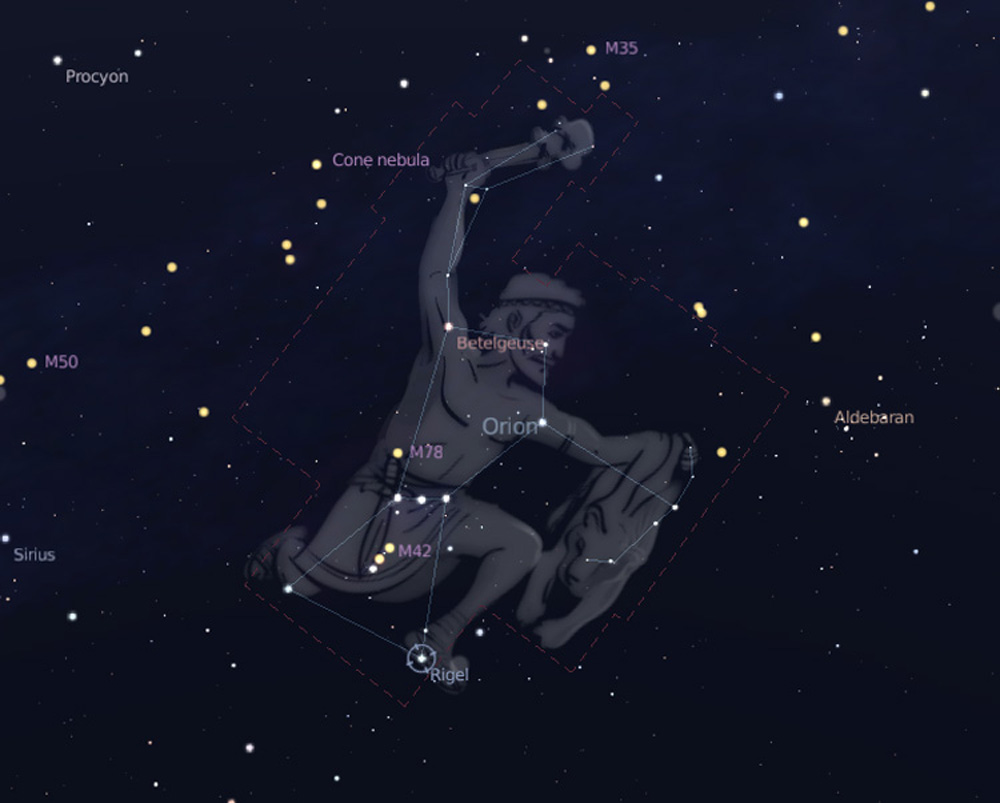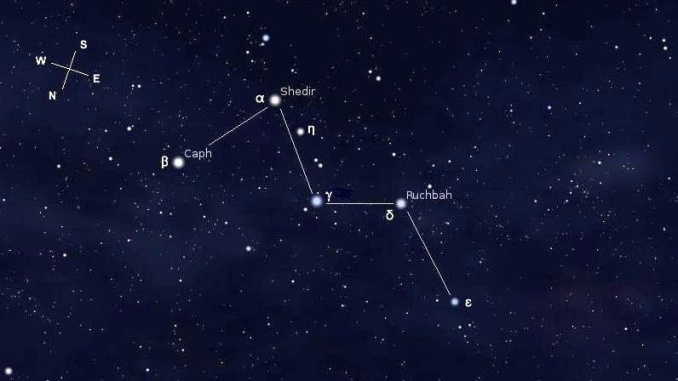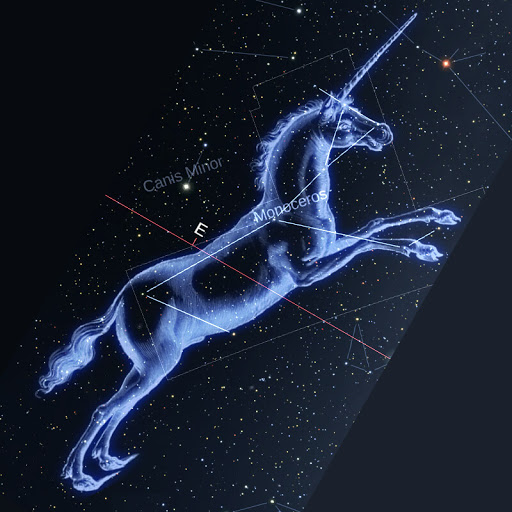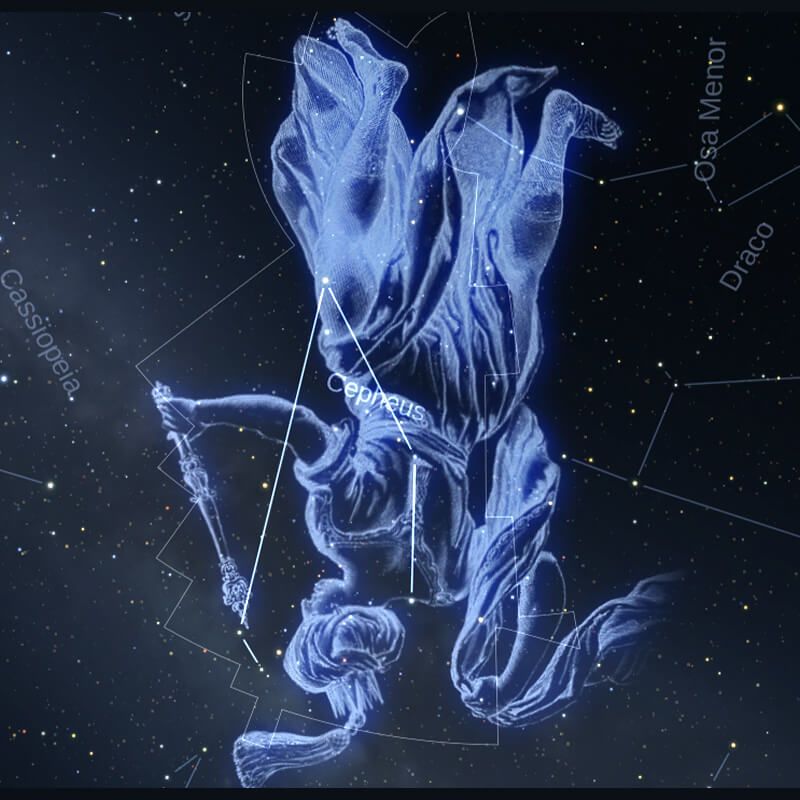For astronomical science, a constellation is a meeting of stars, which have a location that is best observed at night and that gives the idea that they are in a constant position. If you want to know more about the constellations, its composition, its history and more, we invite you to enjoy this article.
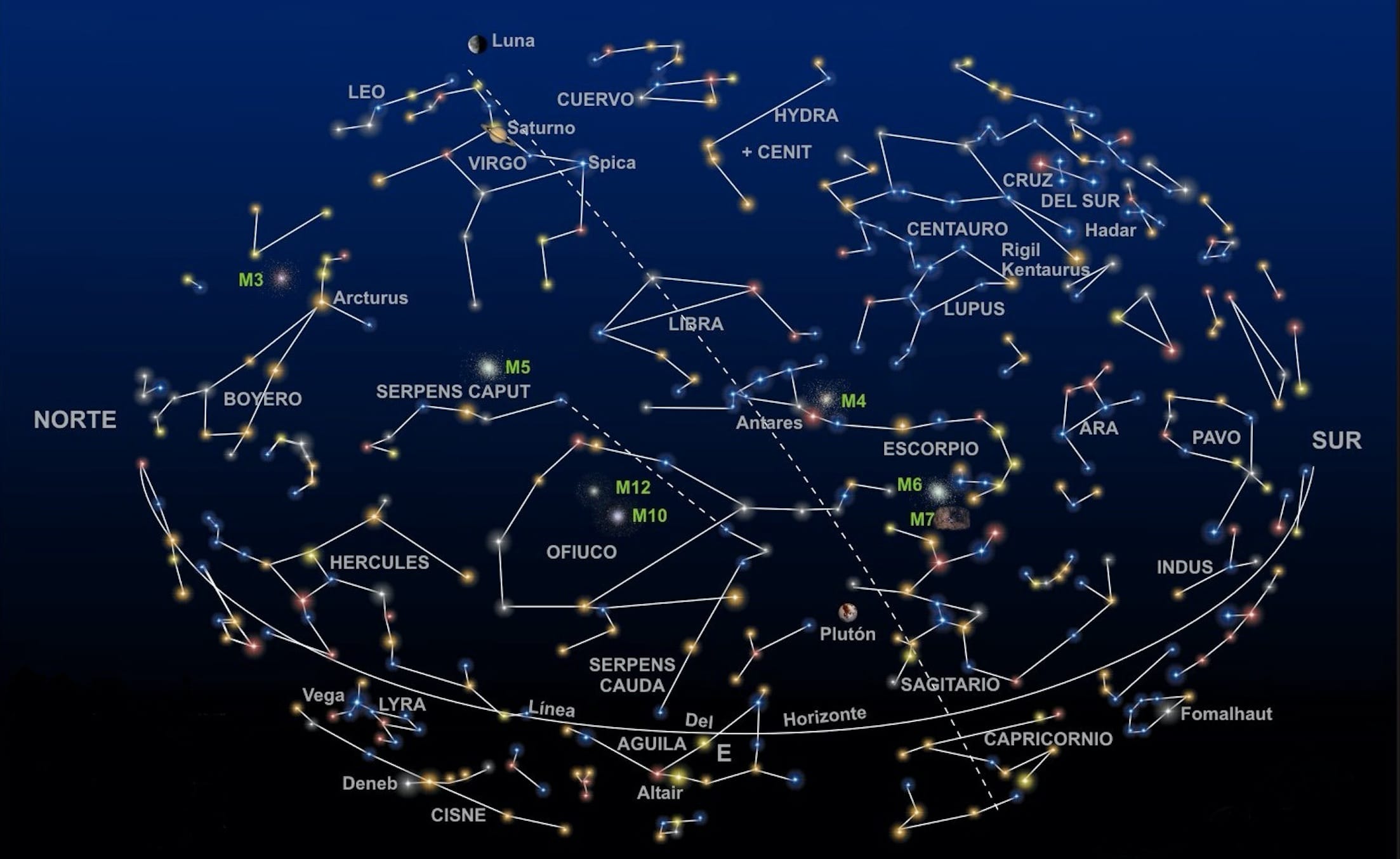
What are the constellations?
In principle they were groups of stars that existed from the Origin of the universe, that the ancient peoples decided to unite by means of imaginary lines, creating fictitious drawings that they observed in the night skies. But the position in which they are when observed from Earth does not necessarily bear a relationship with respect to the position in which they truly are in the extension of the universe.
It has even been possible to determine that some of these stars, joined by imaginary lines, are not located in the same quadrants of space; moreover, it has been proven that many of them are light years apart from each other, although their initial description has placed them as stars that are found in nearby places.
Another interesting conclusion that has been reached from the analysis of ancient star clusters in constellations, is that, in principle, they were linked in a completely capricious way, because some civilizations grouped them in different ways, sometimes using the same star to unite them in their representations.
Mediterranean and the Middle East
The contribution made by the human settlements that occupied places such as the Mediterranean and the Middle East is very relevant, because they were capable of making signs of constellations centuries ago. It is also interesting to verify that southern peoples had recognized and named several constellations, starting from their beliefs, above all, religious.
But where a great influence of Mediterranean and Eastern astronomy was observed was in the peoples who lived to the south, which took the names that the Europeans gave to the constellations and they began to study astrological formations that until then were not known to them.
The celestial hemispheres are divided into two sections, so astronomers have classified the constellations into two groups, according to their location in the recognized celestial hemispheres, which are:
Constellations northern, which are those that are located north of the equatorial line of the sky.
Constellations australes, those that are located to the south of that same imaginary line.
So much importance was given to the study of the constellations of stars that already in 1928 the International Astronomical Union (IAU) had been constituted, who in that same year officially grouped the celestial globe in 88 constellations, establishing specific boundaries between them, making every star visible in the sky, including the Pulsars were included within the limits of a figurative representation of a constellation.
Before 1928, they had already discovered constellations more girls, which were created to gather celestial bodies that did not belong to any of the existing images, but with the catalog that was made in that year, they fell into disuse and were omitted, due to the definitive classification made by the International Astronomical Union ( IAU).
Characteristics of the constellations
They are characterized by being stars to which man has assigned figures that they have constructed in a fictitious way in the celestial vault, and they are also only observed at night. They can be used to more easily locate the place where the stars are. But each constellation has characteristics that are its own and make it unique, such as its position, its formation and its extension.
history of the constellations
Throughout the history of peoples, it has been possible to determine that many civilizations were aware of the existence of constellations and each one attributed a powerful meaning to them, usually mystical and protective. From the studies carried out, it has been possible to establish a history of the constellations, according to the knowledge of the peoples, which we proceed to detail:
ancient constellations
It has been possible to find historical records that prove that constellations like Leo, Taurus and Scorpio they were already known in Mesopotamia, around 4000 years before Christ, although with other names, for practical or mystical purposes. As well as a form of orientation for the crossings
The progress in the study of the heavens in ancient times was so relevant that of the 88 groups of stars that were classified by Eugène Joseph Delporte for the International Astronomical Union (IAU), practically 50% arose from what ancient astronomers imagined. Greece but we must remember that in the ninth century before Christ, Homer already alluded to the constellation of Orion in his work The Odyssey.
The Zodiac, divided into twelve constellations, had its origin in Babylon, at the time of the empire of Nebuchadnezzar II, in the sixth century BC. C., establishing a relationship between each of the celestial images and the twelve lunar periods of the year. Later it was adopted by the Greek civilization, granting the constellations the name they currently have.
The compendium of constellations oldest that has been found dates from the time of Claudius Ptolemy, who drew up a classification of 1022 stars, gathered in 48 constellations, in his work called Almagest, in the XNUMXnd century BC. c.
chinese constellations
It has been established that the Chinese star formations are the constellations oldest in the world. But it's about constellations very different from those known today by the International Astronomical Union, as expected, because the latter was based, above all, on the astrology of the Greek people.
Chinese astronomical studies divided the celestial vault into 31 zones, of which 3 received the name of enclosures (sān yuán), located in the vicinity of the North Pole, and 28 were called mansions (èrshíbā xiù) and were located in the area of the North Pole. zodiac.
Hindu constellations
The astronomers of the ancient Hindu civilization gathered the stars and asterisms, forming an image relatively similar to the one they wanted it to be represented, on the condition that the image was always upright. The name they gave to the constellations it was nakshatra, which means lunar mansion and there are 27 lunar mansions.
A list of the lunar mansions or Nakshatras can be seen in the ancient Vedic texts, and also in the Shatapatha Brahmana. The first book related to astronomy that mentions them is the Vedanga Jyotisha of Lagadha. Reviewing Hindu mythology, we will find that the Nakshastras were a creation of Daksha, and are understood to embody the daughters of that deity and are the wives of Chandra, who is the moon god.
Inca constellations
The study of the heavens had been a subject of extensive treatment in the civilization of the Incas. He even already had a classification of 2 classes of constellations, which were the Constellations Stellar or Brilliant, while the second class of constellations It is formed by concentrations of interstellar dust and gas, which form dark shadows that dominate spaces inside the Milky Way, called Constellations Dark or Black.
Other pre-Columbian cultures
For the culture of the Nahuas, the constellation that corresponds to the Big Dipper personified the figure of a Jaguar (Ocelotl). It is still a mystery Mayan astronomy.
In the case of the Mexicas, who in their language had the word Citlalli, which literally means star, it has been established that they made their own observations of the night skies and that they had identified around 30 constellations.
The Chibchas had established a correspondence between the heliacal rising of the star Sirius and the time when the rainy season began.
The Mocovíes thought that the Milky Way was like a road, which they called nayic, which ran towards a mountain and in all its extension was surrounded by multiple asterisms, which were linked to legends and stories of meetings between shamans and entities. powerful, called owners, with whom they made deals to achieve survival.
The cultures that inhabited northern Patagonia, around the XNUMXth and XNUMXth centuries, had the belief that the Milky Way constituted the figure of a field to hunt rheas, in which the hunters used boleadoras that were drawn by means of a pointer, formed by alpha and beta Centauri, while the Magellanic Clouds were a representation of the corpses of the animals that had been hunted and the Pleiades, which were called the seven kids, which formed the nest of the rhea.
other latitudes
Particularly interesting is the study of the culture of the Australian aborigines and their astronomical knowledge, especially those who had their settlements in the center of their continent, because they had managed to identify figures with dark lines in their night skies.
Likewise, the South American aboriginal cultures had been able to observe and identify the darkened areas in the Milky Way, which are clouds composed of cosmic dust that absorbs the light emanating from the stars or cases such as the Oort Cloud and, by means of them, they managed to imagine their constellations. It constitutes one of his constellations The most represented in their culture is that of the Emu in the Sky, which is part of their mythology and extends from the Scorpion area to the Southern Cross area.
zodiacal constellations
First of all, it should be explained that the Zodiac is an imaginary line in the sky along which, in theory, the sun and the planets move. In the fifth century a. C. that area of the sky was divided into 12 sections of the same size, one of them for each month of the year, giving them the name of the constellations that were inside them or in their adjacencies, constituted asterisms, whose existence before the zodiac was invented is perfectly probable.
Ptolemy's constellations
In addition to twelve constellations of the Zodiac, Ptolemy made some studies of the heavens that allowed him to identify 36 more representations, which were included in a map made by Dürer in 1515.
Thanks to their studies, the 48 constellations described by Ptolemy in his work, became those that were collected by Western science until the end of the Middle Ages. The only exception was Argo Navis or the ship of Argos, named after the ship of the Argonauts in Greek mythology, which was divided into four constellations individuals later, which were accepted without modification by the International Astronomical Union.
modern constellations
The reason for the formation of constellations was to be able to incorporate stars that had already been detected and described but that could not be observed from the city of Alexandria, where Ptolemy did his studies, but that could be seen from the south of that city. Fortunately for astronomy, at the end of the Middle Ages, Ptolemy's work could be recovered for the Europeans, thanks to the translation of it into Latin from Arabic sources.
But nothing prepared the astronomers of the XNUMXth century, when navigators ventured from Europe to explore the southern oceans, because the sailors found unprecedented skies, which possessed stars that had not yet been identified. So out of the need for navigation aids came the new constellations.
Johann Bayer and Uranometry
In the year 1603, a German astronomer named Johann Bayer published his research under the name of Uranometry, constituting the first astronomical map that could describe the entire environment of the night skies. In addition to the 48 Ptolemaic clusters, Bayer included 12 more, which belong to the southern section of the planet, because they could only be observed from that location.
Its creation is due to the Dutch sailor Pieter Dirkszoon Keyser, who was helped by Frederick de Houtman, during a voyage to the South Seas between 1595 and 1596, the year in which Keyser also died during his expedition.
Inventions of Nicolas Lacaille
Nicolas Louis de Lacaille, was an abbot, astronomer and mathematician in France, who had the opportunity to live in South Africa, in the period between 1750 and 1751, and assigned himself the task of establishing a systemic relationship of the stars located in the night sky of the southern hemisphere. His creation received the name Coelum australe stelliferum.
Lacaille's designs and images, contrary to the previous ones, honored the creations of human ingenuity, which constituted the way of thinking of that time.
southern constellations
Between the years 1877 and 1879, the Argentine National Observatory, today called the Astronomical Observatory of Córdoba, published the atlas and catalog of the well-known Argentine Uranometry, containing the location and brightness characteristics of all the stars that are observable with the naked eye between the pole South and declination -10°.
constellations today
The borders of the constellations, in general, continue the lines, equally imaginary, that were agreed upon by the International Astronomical Union from 1928 to 1930. These limits use as a guide the lines of declination and right ascension for the time, using the location of 1875,0, reason for which there are no diagonal lines.
From that moment, due to the movement of precession, which is the displacement of the Earth movements In relation to the stars, these borders have been relocated, but the area occupied by each sign has remained the same.
According to those borders, the Southern Cross is the smallest constellation in the celestial vault, with only 68 square degrees, covering an area of 1/600 of the sky. The largest is Hydra, which with 1.300 square degrees occupies 3% of the total sky. and the three constellations The largest cover 10% of the night sky, that is, as much as the 27 smallest.
At present, constellations have receded into the background. Professional scholars of the heavens now refer to the bodies of the universe by their location on the celestial sphere, using the coordinate system. In general, only amateur astronomers are interested in learning about and studying the shapes of the constellations.
Getting ready to see the constellations?
If you want to correctly locate the constellations, it is required that the stars with which their figures are drawn can be observed. People who live in cities cannot see them well, due to light pollution, which adversely affects the visibility of stars with less brightness.
What is recommended, if you want to learn about constellations, is to locate a dark place. The correct way to start studying them is to start by choosing one, which may be the first one you have seen and recognized. After we have identified it, you should look to the sides to be able to identify the constellations adjacent.
We must have an atlas or map of the celestial vault or a guide for the naked eye, the latter will help you identify the drawings found on paper in the sky and can be purchased at any bookstore.
The difficult one is the first, but when you have managed to identify it, you will be able to observe those that are next to you in addition. If it is among your options, you can ask a person who knows a constellation for help and with that you can draw your own map.
constellations and examples
In ancient times, only a small number of shining stars were baptized with their own names, even some of them were considered a constellation. Later, the Arab scientists, with their observational work, gave names to many others.
The criteria for assigning them a name were based on the position in which each star was located within its constellation. Aldebaran, which is the brightest body in the constellation of Taurus, owes its name to the Arabic words al-Dabaran, which means the one that follows, due to its position with respect to the Pleiades.
In Taurus we also have Alnath (or Elnath), from the Arabic an-Nath, which means the tip of the horn.
In addition to the classical nomenclatures, whose origin can be Greek, Latin or Arabic, the stars can have a name made up of a letter of the Greek alphabet in lowercase, which follows a decreasing order, in relation to its apparent magnitude.
This method of naming stars was invented by Johann Bayer in the XNUMXth century. Later, John Flamsteed began assigning Arabic numerals to name the stars in each constellation.
In both systems, the letters or numbers must be followed by a Latin genitive derived from the name of each constellation. For example, Aldebaran and Alnath are also known as Alpha (α) and Beta (β) Tauri according to the Bayer method, or 87 and 112 Tauri according to the Flamsteed nomenclature. They may have other names, but this will obey the different catalogs that have been created. Therefore, a star can have several names.
In the case of double or variable stars, other nomenclatures must be used, which will depend on the catalogs in which they are found. Another aspect to consider is that, within the borders of the constellations there are other celestial bodies that are not stars, such as planetary nebulae or galaxies and that have been classified
How to see the constellations in the sky?
All the constellations that are recognized today, have undergone many changes in the course of the ages, since the world is a human world. Several have had their birth in the beginning of time and others have a more recent date. No one knows for sure what the constellations Older. Ursa Major is thought to be one of the oldest, dating back to the time when ice covered the planet.
This constellation was popular among the native peoples of Siberia and Alaska, information that suggests that there is evidence of its existence since before the ice melted and the bridge that existed in the Bering Strait and that joined the two broke. continents.
The observable constellations today
Today astronomers, both professional and amateur, are fortunate to have a guide that allows them to recognize the constellations found in the night skies and for people to learn a little more about them. In this article we will make a list of the most important:
Keel Constellation
The constellation of Carina or the Keel is located in the second quadrant of the southern celestial hemisphere. It can be observed at latitudes between +20° and -90°. It was part of a larger constellation, formerly called Argo Navis, but was divided by the International Astronomical Union into four: Carina, Vela, Puppis and Pyxis. It includes in its formation the second most radiant star in the night sky, Canopus.
Constellation of The Golden Fish
The constellation of La Dorada is located in the first quadrant of the southern hemisphere and it is possible to observe it at latitudes between +20° and -90°. Its name means the golden fish (Coryphaena hippurus) in Spanish. Dorado encompasses the largest expanse of the Large Magellanic Cloud, an irregular galaxy near the Milky Way. It features two stars that have known planets. Its brightest star is Alpha Doradus.
Aquarius constellation
The constellation of Aquarius is in the southern hemisphere, in the area of the celestial vault known as the Sea, because it contains a number of constellations that have names linked to water; such as Pisces (the fish), Eridanus (the river) and Cetus (the whale), among others. It is visible at latitudes between +65° and -90°. It was cataloged by the Greek astronomer Ptolemy in the 2nd century. It contains the famous supergiant star Beta Aquarii and a number of notable deep sky objects such as the globular clusters Messier 72 and Messier 73 or the asterism Messier XNUMX.
Centaurus Constellation
The Centaurus constellation is situated in the third quadrant of the southern hemisphere and is observable at latitudes between +25° and -90°. It is one of the constellations largest in the sky. It represents the centaur, the half-man, half-horse creature of Greek mythology. Sources tend to differ on which centaur the constellation represents, but it is generally considered to have been Chiron, mentor to the Greek heroes Hercules, Peleus, Achilles, Theseus, and Perseus.
Centaurus contains two of the ten brightest stars in the sky: Alpha Centauri and Beta Centauri. It is also home to Centaurus A, one of the brightest galaxies in the night sky, and the globular cluster Omega Centauri. Its origin is Ptolemaic and inside there are 11 stars with known planets. There are also meteor showers associated with this constellation.
Andromeda Constellation
This constellation is located in the first quadrant of the northern hemisphere and can be seen at latitudes between +90° and -40°. It is named after the mythical princess Andromeda, the wife of the Greek hero Perseus. Its origin is Ptolemaic. It is an important constellation because it includes the galaxy of the same name (Messier 31), and the dwarf elliptical galaxies Messier 32 (Le Gentil) and Messier 110.
Hercules constellation
Hercules is situated in the third quadrant of the Northern Hemisphere and is observable at latitudes between +90° and -50°. It has a long history, which goes back to the Sumerian era. It is linked to the penultimate work of Heracles, which was to kill the dragon Ladon, guardian of the garden of the Hesperides. The dragon also appears in the heavens, in the constellation of Draco. The origin of it is Ptolemaic. It is associated with the Tau Herculidas meteor shower. It includes a globular cluster and two galaxy clusters: Hercules and Abell.
Pegasus constellation
The Pegasus constellation is situated in the fourth quadrant of the Northern Hemisphere and can be observed at latitudes between +90° and -60°. It was named after the winged horse of Greek mythology and its origin is Ptolemaic. Inside it contains radiating stars and deep-sky objects, including Messier 15 (NGC 7078, Pegasus cluster), Stephan's quintet of galaxies, Einstein's Cross (a gravitationally lensed quasar), and the spiral galaxy NGC 7742.
Swan Constellation
Cygnus, or the Swan, is situated in the fourth quadrant of the Northern Hemisphere and can be observed at latitudes between +90° and -40°. The Swan is linked to the Greek myth of Zeus and Leda. It is very easy to find in the sky, because it includes the asterism called the Northern Cross. Its origin is Ptolemaic. It has within it Cygnus X-1, a well-known source of X-rays.
It contains the stars Deneb and Albireo. There are two meteor showers related to the constellation, which are the October Cygnidas and the Kappa Cygnidas.
Ursa Major Constellation
It is situated in the northern sky. The Big Dipper is the largest northern constellation and the third largest constellation in the vault of heaven. The most radiant stars in it give shape to the Big Dipper or El Carro asterism, which is one of the most recognizable. It is a Ptolemaic constellation. She is linked to several myths, but the best known is that of Callisto, a Greek nymph who was transformed into a bear by the goddess Hera.
Within it, it contains a variety of stars and deep-sky bodies, such as the Pinwheel Galaxy (M101), Bode's Galaxy, the Cigar Galaxy, and the Owl Nebula.
Constellation Ursa Minor
Ursa Minor is situated in the third quadrant of the Northern Hemisphere and is observable at latitudes between +90° and -10°. It is easy to see because it emphasizes the location of the north celestial pole, being the home of Polaris, the North Star, which is at the end of the constellation. It is thought that it was created by Thales of Miletus, who lived in Greece between 625 and 545 BC. The Phoenicians used it as a reference for navigation. It is linked to a meteor shower, called the Ursids.
Taurus constellation
Taurus is located in the first quadrant of the Northern Hemisphere and can be observed at latitudes between +90° and -65°. His name means bull in Latin. It was created by Ptolemy, but its history dates back to the Bronze Age. It is one of the oldest known. In Greek mythology, she was linked to Zeus, who turned into a bull to approach Europa and kidnap her. It contains very radiant stars like Aldebaran or Alcíone.
It also contains the Pleiades (Messier 45), also called the Seven Sisters, and the Hyades, which are the two closest open star clusters to Earth. It also includes the Crab Nebula, the Crystal Ball Nebula (NGC 1514), and the Merope Nebula (NGC 1435). The constellations neighbors are Aries, Eridanus, Gemini, Orion and Perseus.
Leo Constellation
It is situated in the second quadrant of the Northern Hemisphere and can be seen at latitudes between +90° and -65°. It represents a lion and is linked to the Greek myth of the Nemean lion. Its origin is Ptolemaic. Within it are radiant stars like Regulus and Denebola. It is related to two meteor showers, known as the Leonids. She is a neighbor of constellations of Cancer, Hydra and the Great Bear.
Orion Constellation
It is one of the most scintillating and famous in the celestial vault. It is located at the equatorial point. It has been known since ancient times. In Greek mythology he personifies the hunter Orion, who is drawn on star maps, fighting with Taurus or in pursuit of the Pleiades, he also appears hunting the Hare, which is the constellation Lepus, together with his two dogs, which are constellations adjacent, known as Canis Major and Canis Minor.
This star formation encompasses the ten most radiant stellar bodies in the night skies, including Rigel and Betelgeuse. There are two meteor showers linked to Orion, the Orionids and the Chi Orionids. The maximum point of the same occurs approximately on October 21 of each year.
scorpio constellation
Scorpio is situated in the third quadrant of the southern hemisphere and can be seen at latitudes between +40° and -90°. It is linked to the Greek myth of Orion. Its origin is Ptolemaic. It is one of the oldest. The Sumerians named it Gir-Tab, or the scorpion, about 5.000 years ago. It is easy to find it in the skies because it is located in the center of the Milky Way. Its brightest star is Antares and it has two linked meteor showers, the Alpha Scorpids and the Scorpids.
Cassiopeia constellation
It is located in the first quadrant of the northern hemisphere and is observable at latitudes between +90° and -20°. It was named after a shallow and vain queen from Greek mythology. Its origin is Ptolematian and it can be seen in the sky because it has a W shape. Its most radiant star is Schedar and it has a related meteor shower, the Perseids.
It contains relevant celestial bodies, such as the open clusters Messier 52 and Messier 103, the Heart Nebula and the Soul Nebula, as well as what remains of the Cassiopeia A supernova or the star-forming cloud that has the popular name of Pacman nebula. . It is a neighbor of Andromeda, Camelopardalis, Lacerta and Perseus.
Capricorn constellation
The Goat or Capricorn is one of the most fragile in the celestial vault. It is located in the fourth quadrant of the southern hemisphere and it is possible to observe it at latitudes between +60° and -90°. Its origin is Ptolemaic and it is linked to the Greek myth of the god Pan and the goat Amalthea, who nursed Zeus. The Goat is home to several major stars and to the well-known globular cluster Messier 30. Its brightest star is Deneb Algedi.
It is interesting that, being the most fragile, it has a large number of meteor showers linked to it, which are the Alpha Capricornids, the Chi Capricornids, the Sigma Capricornids or the Tau Capricornids.
Canis Major Constellation
Canis Maioris or Canis Mayor is located in the second quadrant of the southern hemisphere and can be seen at latitudes between +60° and -90°. It represents the dog that follows the hunter Orion of the Greek myth. It is common for the largest dog to be depicted behind a hare, which is the Lepus constellation. The smallest dog is represented by the neighboring constellation Canis Minor. Both are of Ptolemaic origin.
In this constellation we find the star Sirius, the most radiant star in the night sky, as well as other important bodies in the deep sky, such as the open cluster Messier 41, the emission nebula NGC 2359, known as Thor's helmet, and the galaxies colliding spirals NGC 2207 and IC 2163.
Camelopardalis Constellation
Camelopardalis, or the Giraffe, is located in the second quadrant of the Northern Hemisphere and is observable at latitudes between +90° and -10°. It was created by the Dutch astronomer Petrus Plancius and documented by the German astronomer Jakob Bartsch in 1624. It contains the Kemble Cascade, which is an asterism made up of a cascade of 20 stars considered dim due to their brightness, located in a row.
It contains three stars with planets that are known. The brightest star in the constellation is Beta Camelopardalis. The Camelopardalids in October are the only meteor shower linked to this constellation.
Sail Constellation
La Vela is located in the second quadrant of the southern hemisphere and it is possible to see it at latitudes between +30° and -90°. It was once part of another larger constellation, the Argo Navis, which alluded to the ship of the Argonauts from the Greek myth of Jason, but was eventually divided by the astronomer Nicolas de Lacaille into four. constellations smaller: Carina, Vela, Puppis and Pyxis, in the year 1750. Its origin is Ptolemaic.
Within the Vela constellation are a variety of intriguing stars and striking celestial objects, including the Eight Bursts Nebula (NGC 3132), the Gum Nebula, the remains of the Vela Supernova explosion , the Pencil Nebula (NGC 2736) and the Omicron Velorum Cluster (IC 2391). Its brightest star is Gamma Velorum and there are three meteor showers linked to this constellation: the Delta Vélidas, the Gamma Vélidas and the Vélidas.
Sagittarius constellation
Sagittarius is situated in the fourth quadrant of the southern hemisphere and can be observed at latitudes between +55° and -90°. Its origin is Ptolemaic and it is drawn as a centaur tending a bow with an arrow. It is very easy to locate in the Milky Way, since its stars form an image known as The Teapot. It is said to be linked to the Greek myth of the centaur Chiron. Its brightest star is Kaus Australis. The closest star to Earth is Ross 154, located just 9.69 light years away.
The constellation encloses the Arcus Cluster, the Quintuple Cluster, with the luminous star Pistol, the Galactic center, the radio source Sagittarius A, and a number of well-known deep-sky objects, including the Sagittarius Dwarf Elliptical Galaxy. , the Sagittarius Dwarf Irregular Galaxy, the Bubble Nebula, and up to 15 Messier objects, including the Sagittarius Star Cloud (Messier 24), the Omega Nebula (Messier 17), Messier 18, the Lake Nebula (Messier 8 ) and the Trifid Nebula (Messier 20).
Monoceros constellation
Monoceros is situated in the second quadrant of the Northern Hemisphere and is observable at latitudes between +75° and -90°. His name means unicorn in Latin. It was created by the Dutch astronomer and cartographer Petrus Plancius from the observations of Dutch navigators in the XNUMXth century. It resembles the mythical creature with a horn much like a horse.
It is a constellation considered fragile, with some stars of fourth magnitude, but it is the home of famous stars such as the variables S Monocerotis, R Monocerotis and V838 Monocerotis, Plaskett's star, which is one of the most voluminous binary stars known. know, and the triple star Beta Monocerotis.
Monoceros is also home to several notable deep-sky bodies, including the open cluster Messier 50 (NGC 2323), the Rosette Nebula, the Christmas Tree Cluster, the Cone Nebula, and the Hubble Variable Nebula, among others. others.
Apus Constellation
The Apus constellation is situated in the third quadrant of the southern hemisphere and can be seen at latitudes between +5° and -90°. It is a small constellation that has the figure of a bird of paradise. Its name comes from the Greek word apous, which means without feet, because at one time it was thought that the birds of paradise did not have them. It was created by the Dutch astronomer and cartographer Petrus Plancius from the observations of the Dutch navigators Pieter Dirkszoon Keyser and Frederick Houtman.
Apus is home to two star systems that have known exoplanets, HD 131664 and HD 134606. The brightest star in this constellation is Alpha Apodis. The closest star is HD 128400, which is 66,36 light years from Earth.
Crater Constellation
The Crater constellation is situated in the second quadrant of the southern hemisphere and is observable at latitudes between +65° and -90°. Its name means the cup, in Latin. Its origin is Ptolemaic and in Greek mythology it is linked to the cup of the Greek god Apollo, which is usually shown as a chalice and two hands. It is also associated with the myth of Apollo and his sacred bird, the raven, which is drawn in an adjacent constellation, that of Corvus.
It contains three stars with known planets. Its brightest star is Delta Crateris. There is a meteor shower linked to this constellation, the Eta Craterids.
Compass/Pyxis Constellation
The Pyxis or Compass constellation is located in the second quadrant of the southern hemisphere and can be seen at latitudes between +50° and -90°. His image is a sailor's compass. Pyxis was created by French astronomer Nicolas Louis de Lacaille in the XNUMXth century. He originally called her Pyxis Nautica, but his name was later shortened to Pyxis. It is one of the resulting divisions of the constellation Argo Navis, which was linked to the Greek myth of the Argonauts and Jason.
The brightest star in Pyxis is Alpha Pyxidis. It encloses some relevant deep-sky bodies, including the planetary nebula NGC 2818, the open group NGC 2627, and the Barrada spiral galaxy NGC 2613.
Constellation Auriga
The Auriga constellation is located in the first quadrant of the Northern Hemisphere and can be observed at latitudes between +90° and -40°. Its name comes from Latin. That name was given to it because its main stars are formed in a way that you can see the image of the pointed helmet of a charioteer, who was the person who drove the Roman chariots. Its origin is Ptolemaic. The brightest star in this constellation is Capella.
This constellation is located at the site of the anti-center of the galaxy, which is the opposite place to the center of the Milky Way. The radiating star of this constellation that is closest to the anti-center of the galaxy is Alnath or Beta Tauri.
It also includes some relevant astronomical objects, such as the open star clusters Messier 36, Messier 37, and Messier 38 and the emission/reflection nebula IC 405, called the Flaming Star Nebula. There are two meteor showers associated with Auriga, the Alpha Aurígidas and the Delta Aurigidas.
Grus Constellation
The Grus constellation is located in the fourth quadrant of the southern hemisphere and can be observed at latitudes between +34° and -90°. Its name means crane in Latin. It was created by the Dutch astronomer Petrus Plancius, based on the observations of the Dutch navigators Pieter Dirkszoon Keyser and Frederick de Houtman at the end of the XNUMXth century.
Grus contains three bright stars and one star that is located 32.6 light-years from Earth. The brightest star in this constellation is Alnair, Alpha Gruis. The closest star is Gliese 832, located at a distance of only 16.15 light years from Earth.
Constellation Cepheus
The constellation of Cepheus or Cepheus is situated in the fourth quadrant of the northern hemisphere and it is possible to observe it at latitudes between +90° and -10°. It is one of the constellations of Ptolemaic origin. His name was given in honor of the Greek myth of King Cepheus of Ethiopia, married to Queen Cassiopeia and father of Andromeda, who was the wife of Perseus. Both constellations, Cassiopeia and Andromeda, are in the vicinity of Cepheus.
This constellation is home to Garnet Star, one of the largest known stars in the Milky Way, and to several commonly known deep-sky bodies, such as the Wizard Nebula, the Iris Nebula, and the Galaxy. of the Fireworks. Its brightest star is Alderamin, Alpha Cephei.
Constellation Microscopium
The Microscopium constellation is located in the fourth quadrant of the southern hemisphere and can be seen at latitudes between +45° and -90°. He was given the figure of a microscope. Its location is south of the constellation of Capricorn. It is a small fragile constellation, very difficult to observe from northern latitudes. It was created by the French astronomer Nicolas Louis de Lacaille in the XNUMXth century.
The most radiant stars in Microscopium are only fifth magnitude. It is the home of a star with known planets. The brightest star in the constellation is Gamma Micoscopii. Its current official astronomical limits are the same as those established by the Belgian astronomer Eugène Delporte in 1930.
Constellation Sculptor
The Sculptor constellation is located in the first quadrant of the southern hemisphere and can be observed at latitudes between +50° and -90°, south of the constellations of Aquarius and Cetus. It was created by the French astronomer Nicolas Louis de Lacaille in the XNUMXth century. Lacaille, at first, baptized it as Apparatus Sculptoris, which means the sculptor's studio, but later it was simplified to that of Sculptor.
It is a fairly fragile constellation, with no stars more radiant than third magnitude. It is interesting because it has a south galactic pole and is home to some relevant deep sky bodies, such as the Cartwheel Galaxy, the Silver Coin Galaxy (NGC 253), and the Sculptor Dwarf Galaxy.
The brightest star in the constellation is Alpha Sculptoris. The nearest star is Gliese 1 (spectral class M1.5V), located at a distance of 14.22 light-years from Earth.
https://www.youtube.com/watch?v=3eBAcEcfo24



